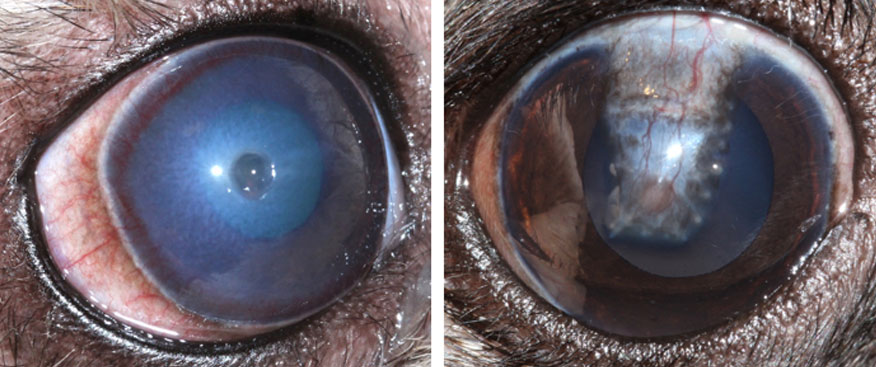Corneal surgical repair
The aims of corneal surgical repair are to encourage corneal healing as well as prevent further severe complications such as globe rupture.
Globe rupture occurs when the ulcer no longer affects the first most superficial layer of the cornea (epithelium), instead it has reached all the corneal thickness and created a communication between the outside and the inside of the eye. Globe rupture can occur secondary to a severe trauma, however it is most common secondary to a complicated and likely infected corneal ulcer. If a globe rupture occurs, does not mean that vision in that eye is permanently lost, however there is a increased risk of blinding complications can occur – such as cataract formation, retinal detachment or infection inside the eye. For this reason, corneal surgical repair is important to be performed promptly when a deep corneal ulcer appears.

Which surgical options exist?
There are several options available. However, they all share the same principles: we will place tissue to fill the deep ulcer and encourage healing. This tissue will be held on the eye by small surgical sutures (thinner than human hair!) and will remain there for the first few weeks. During the first three weeks after surgery, will be very important that this sutures are not distorted!
- Conjunctival graft: We use the patients own tissue, in this case the conjunctiva, to fill the defect.
- Corneal conjunctival transposition (CCT): We use the patients own tissue, in this case part conjunctiva and part cornea, to fill the defect.
- Other grafts: There are several available tissues that we can also use – such as amnion, bladder tissue, intestinal tissue, or even donor corneal tissue! The benefits of using exogenous tissue (not belonging the own patient) is that the healthy ocular tissue is not altered; however there are potentially more risks of rejection.
If your pet is undergoing corneal surgical repair, we will consider all the options and decide which one is best of your pet. We will explain you with more detail each one as well as why do we consider a particular option the most adequate for your pet!
Can a deep corneal ulcer be treated with eye drops only?
- In some cases, we will recommend to wait before going ahead with surgery. This is because we have reasons to believe that the cornea may heal without surgical intervention or because we think the scarring after surgery will not be in your pet’s best interest.
- Generally, we will recommend medical treatment (eye drops) in younger cooperative patients, for ulcer that are showing signs of advance healing.
- These patients will stay in hospital for several days and we will re-assess the need for surgery every day.
To find out more about corneal ulcers, click here
